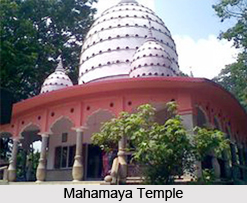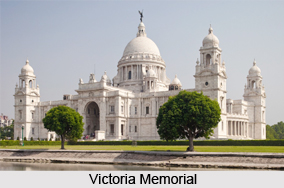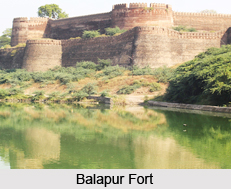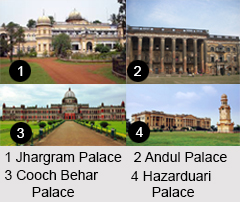 Palaces of West Bengal gives the art and architectural identification of Greco- Roman architecture, Portuguese, Armenian and Jewish sculpture in the palaces, who are now in ruins and some are serving tourists as museums. Some of the palaces of monarchs and the rajbaris of West Bengal are Palace of Bawali, Itachuna Palace, Andul Rajbari, Gaia Rajbari, Baruipur Rajbari, Marble Palace, Bhutan House, Nizam"s Palace, Cooch Behar Palace, Garh Panchkot, Hazarduari Palace, Metcalfe Hall, Namak Haram Deorhi, Cossimbazar Palace, Shobhabazar Rajbari, Tagore Palace and many more. They are the carriers of colonial culture and Oriental culture from the mid 16th Century to 20th Century.
Palaces of West Bengal gives the art and architectural identification of Greco- Roman architecture, Portuguese, Armenian and Jewish sculpture in the palaces, who are now in ruins and some are serving tourists as museums. Some of the palaces of monarchs and the rajbaris of West Bengal are Palace of Bawali, Itachuna Palace, Andul Rajbari, Gaia Rajbari, Baruipur Rajbari, Marble Palace, Bhutan House, Nizam"s Palace, Cooch Behar Palace, Garh Panchkot, Hazarduari Palace, Metcalfe Hall, Namak Haram Deorhi, Cossimbazar Palace, Shobhabazar Rajbari, Tagore Palace and many more. They are the carriers of colonial culture and Oriental culture from the mid 16th Century to 20th Century.
Andul Rajbari
Andul Rajbari is a rajbari in Andul of Howrah District of West Bengal. This palace probably belonged to a zamindar family who ruled in the late 19th century and 20th century. The rajbari is now a heritage site in Andul and is several years old.
Bhutan House
Bhutan House is an estate located in Kalimpong, West Bengal. This palace estate was owned by the Dorji family of Bhutan. The site is the traditional administrative Dzong for southern Bhutan, and also functioned as the administrative centre for the whole of western Bhutan during the modern kingdom`s early years of consolidation. It represented the relationship between Bhutan and British East India Company in India.
Cooch Behar Palace
Cooch Behar Palace is a tourist landmark in Cooch Behar of West Bengal. It was designed on the model of Buckingham Palace in London in 1887, during the reign of Maharaja Nripendra Narayan.
Garh Panchkot
Garh Panchkot is a ruined fort and the zamindar palace located in the eastern part of India at the foot hills of Panchkot in the district of Purulia, West Bengal. The ruins of Garh Panchakot are a silent testimony to the Bargi attack during the 18th century that is the early part of British colonialism in Eastern India.
Hazarduari Palace
Hazarduari Palace earlier known as the Bara Kothi, is located in the campus of Kila Nizamat in Murshidabad, in the Indian state of West Bengal. Hazarduari Palace, now a museum was built in the nineteenth century by architect Duncan Macleod, under the reign of Nawab Nazim Humayun Jah of Bengal, Bihar and Odisha.
Jhargram Palace
Jhargram Raj Palace is the current residence of the Malla Deb Royal family. This palace was situated in Jhargram of Paschim Medinipur district in West Bengal. It is a structure combining the Italian and Islamic architecture model. Jhargram Palace has about 10 rooms plus three dormitories on the ground floor that have been converted into a heritage hotel run by the family.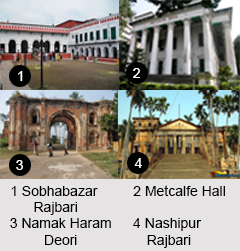
Marble Palace
Marble Palace is a palatial nineteenth-century mansion in Northern part of Kolkata near Kumartuli. Marble Palace is located at 46, Muktaram Babu Street. It is one of the best-preserved and most elegant houses of nineteenth-century Kolkata.
Metcalfe Hall
Metcalfe Hall is a palatial building situated in Dalhousie area of Kolkata, at the junction of Strand Road and Hare Street in the heart of the city`s business district. The architecture of Metcalfe Hall is reflective of the British imperial architecture at the beginning of the nineteenth century. It was built between 1840 and 1844. According to the design prepared by the city magistrate, C.K. Robinson, named after Sir Charles T. Metcalfe who was the Governor-General of India to honour his efforts towards a free press. Metcalfe Hall faces the Hooghly River on the West. The notable Greek order of the architecture of Metcalfe Hall was taken from the Tower of the Winds in Athens, one of the time tested designs of durability and lightness. Metcalfe Hall is raised on a solid basement and thirty huge Corinthian pillars support a massive entablature. The columns and colonnade of Metcalfe Hall surround the whole building. The main entrance of Metcalfe Hall from the West has a giant flight of stairs that has been closed. Metcalfe Hall is now accessed through the portico on the East.
Namak Haram Deorhi
Namak Haram Deorhi which is also known as Traitor`s Gate or Jufarganj Palace was the palace of Mir Jafar. Namak Haram Deorhi is located just opposite to the Jafarganj Cemetery in the Lalbagh area of the town of Murshidabad and near Mahimapur in West Bengal. Namak Haram Deorhi refers to both the places of Mir Jafar and the main gate which leads to the palace. This building was used as the residence of Mir Jafar, before he ascended the throne of Bengal in medieval era or when he was the Commander-in-Chief of the “Subhaâ€.
Nashipur Rajbari
Nashipur Rajbari was the palace of the Nashipur Raj Family. Nashipur Rajbari is a grand palace, situated in Nashipur just adjacent to the palace built by Raja Debi Singha. The current palace was built by Raja Kirti Chandra Singha Bahadur in 1865.
Shobhabazar Rajbari
Shobhabazar Rajbari is the palace of the Shobhabazar royal family located in Kumartuli area of Kolkata. Raja Nabakrishna Deb, founder of the Shobhabazar Rajbari, started life modestly but soon amassed considerable wealth in his service to the British, in particular by his role in assisting to topple Siraj ud-Daulah. During his lifetime Raja Nabakrishna Deb built two houses. The building at 33 Raja Nabakrishna Street (known as Choto Shobhabazar Rajbari), on the northern side of the road, was the one first constructed by him, subsequently given over by him to his adopted son Gopimohan.
Wasif Manzil
Wasif Manzil was built by Nawab Wasif Ali Mirza Khan under the direction and supervision of Mr. Vivian, officer of the Public Works Department of the Nadia Rivers Division and Surendra Barat, a Bengali engineer. Wasif Manzil Palace, rather palace was used by the Nawab as his residence. The building is extremely close to the Hazarduari Palace. It is built on the Nizamat Fort Campus between the campus`s Dakshin Darwaza (south gate) and the Hazarduari Palace, just opposite the campus is South Zurud Mosque and is parallel to the Bhagirathi-Hooghly River.
Bawali Palace
Bawali Rajbari or Bawali Palace was erected in medieval time that is during the rule of Akbar, the Mughal Emperor. Bawali Palace is closely associated with the military life and personal life of Mondal Royal family.
